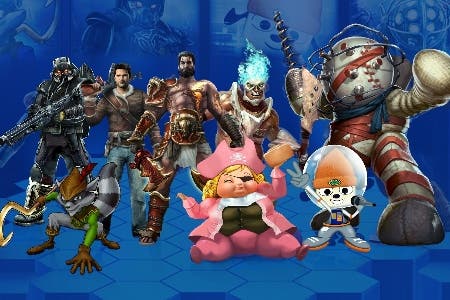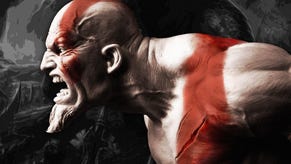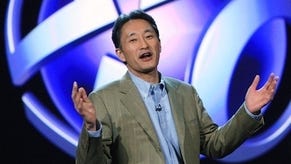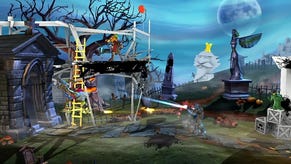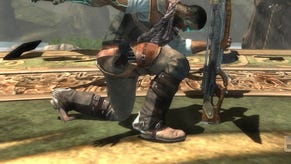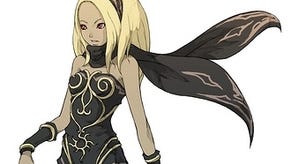PlayStation All-Stars Battle Royale review
PaRappa the slapper.
The thought of a fighting game featuring a cast of characters plucked from Nintendo's heritage was so unthinkable that for a while its thinker, Mashahiro Sakurai, kept it entirely to himself. Knowing the chances of securing Nintendo's permission to pitch Princess Peach against Luigi in a commercial cat-fight were slim, Sakurai made a prototype of his idea in secret.
Even when he eventually showed Nintendo his work - a hyperactive 2D brawler featuring Mario, Donkey Kong, Samus and Fox McCloud - and the company quietly agreed to fund the full game, expectations were low. The Kyoto publisher warned Sakurai that an overseas release was unlikely. But Super Smash Bros. sold close to 5 million copies in Japan and America on its release in 1999 and, perhaps more importantly, sold the fighting game to a demographic for whom Street Fighter's showboating combos had grown inaccessible.
Despite this success, almost 15 years on and no other company has attempted to replicate Sakurai's secret recipe - until now. Then again, what game-maker has enough big-ticket mascots in the vaults to flesh out a full roster of combatants?
In truth, even Sony struggles to find enough of its own characters to populate PlayStation All-Stars Battle Royale, the first mainstream competitor to Super Smash Bros.' playground scuffling. Time is against it, for one: the company's video game history is a decade or two shorter than Nintendo's. Then there's the fact that Sony - especially of late - is a champion of the abstract, and as such relatively few of its recent games are based around characters that could be turned into fighters.
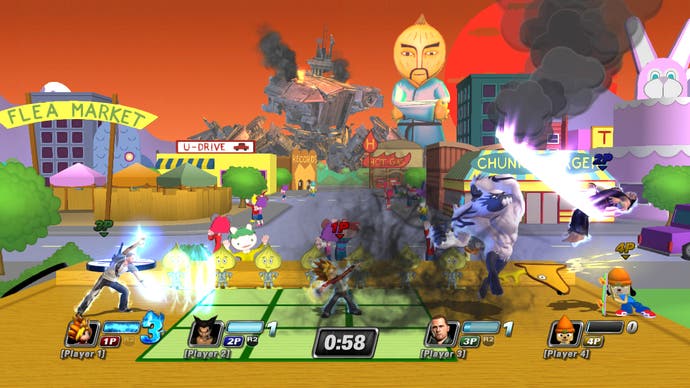
It would be inappropriate to transform Journey's serenely robed figures into kick-boxers, for example, or for the alcohol-fuelled domestic abuse featured in Papo & Yo to spill into a genuine fighting game (although one of Tokyo Jungle's scrappy Pomeranians would make for enticing DLC). The more that video games speak to mature themes, the less apt their actors are for use in fan-service such as this. For that reason, Sony's cast is a more awkward fit for the Smash Bros. template than Nintendo's.
To make up the 22 playable characters, Sony calls up some close collaborators to borrow manpower. BioShock's Big Daddy is brought to the surface from 2K Games. Capcom's Dante (in his new incarnation from next year's Devil May Cry) is joined by Konami's Raiden - while the loan of Tekken's Heihachi Mishima from Namco feels a bit like cheating, considering the wide-angle joke here is to enrol characters unsuited to bare-knuckle fighting.
Elsewhere, Sony's in-house creations fill in the blanks, including the iconic Rodney Greenblat-designed PaRappa the Rapper and Sony's Japanese mascot Toro Inoue (from the Together Everywhere! series). These are joined by Sackboy, Jak and Daxter, Sly Cooper, Ape Escape's Spike and MediEvil's Sir Daniel Fortesque. The strongest characters tend to be the more cartoonish creations, as they allow for the most outrageous, fantastical moves; more lifelike options such as Nathan Drake (Uncharted), Nariko (Heavenly Sword) and Cole MacGrath (in both his good and evil incarnations from inFamous) fall somewhat flat.
"A giant quadrupedal tank enters the scene, firing missiles at the players while duking it out with a 50-foot Chop Chop Master Onion in the middle distance."
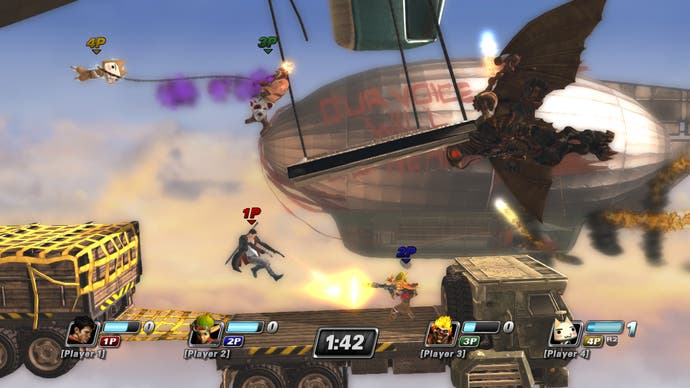
The success of any game of this ilk rests on two core factors: the playfulness and creativity of the fan service, and the knockabout thrills of the fighting itself. On the first count, developers SuperBot Entertainment and Santa Monica Studio succeed. Matches take place in 14 different arenas, each a mash-up two different game fictions. For example, the first stage opens in Chop Chop Master Onion's cardboard dojo, the walls of which collapse midway through the fight so you're fighting in the main street from PaRappa the Rapper. As the battle continues, a giant quadrupedal tank enters the scene, firing missiles at the players while duking it out with a 50-foot Master Onion in the middle distance. [Correction: This tank was initially and incorrectly identified as Metal Gear Rex in this review - it's actually a MAWLR from Killzone 3.]
Later stages combine Uncharted and BioShock, or God of War and Patapon: delicious, incongruous mixes filled with cameos and hyper-specific gags. Each stage has its own arc, disintegrating or morphing during play to change the terrain on which you battle. As with almost every other concept in the game, this idea is lifted wholesale from Super Smash Bros. - and, if anything, the execution is more conservative than in Nintendo's more recent iterations. But it's an effective means of bedding the characters into their environments nonetheless.
Outside of the arenas themselves, the game is stuffed with extras. Each character has three unlockable costumes, various taunts and pieces of victory music, and their thoughtful in-game animations accentuate their personalities. Sackboy momentarily brings up a Pop-It interface before launching some moves, while PaRappa drops a boom box to damage opponents when backed into a corner. The care and attention to detail in this regard runs deep, even when the character it's been lavished upon doesn't necessarily warrant the effort.

Perhaps the best joke in the game is the single-player storyline's final boss, Polygon Man, PlayStation's short-lived mascot in America. Ken Kutaragi, the console's creator, was so infuriated with Polygon Man's design that he demanded Sony America drop the character ahead of the first PlayStation's release. Painfully wronged, Polygon Man is the ideal antagonist for PlayStation All-Stars Battle Royale; the fact he will be recognised by only a tiny fraction of the game's audience elegantly justifies his anger.
In play, PlayStation All-Stars Battle Royale is a far cry from the intricacies of Street Fighter (despite the fact both games feature the same voice-over announcer) but enjoys enough depth and complexity to avoid complaints of button-mashing. Each character has around 30-odd individual moves and, while combo-ing these together is tricky, there is the odd string for the aficionado to master. The most immediate difference to traditional fighting games is that characters display no health bar. Neither do most matches end when any character is defeated. Instead, most games last for a fixed amount of time, the winner being the character who knocks out the greatest number of opponents within that time frame.
Three basic attacks ere mapped to the face buttons, each of which can be modified with different directional inputs. As you damage your opponents you earn AP points, which fill your Super gauge (the only gauge shown on screen). There are three levels of Super attack, the weakest of which will instantly knock out an opponent but which is highly targeted and, therefore, easy to whiff. The second tier of Super is more powerful and sustains for a few seconds, allowing you to take out all opponents if you're quick and exact. The top-tier Super acts more like one of Street Fighter 4's Ultras, with an accompanying animated cut-scene to interrupt the action (in which, for example, PaRappa takes to the stage and raps, or BioShock's Big Daddy fills the scene with water, drowning opponents). Save up your AP for one of these attacks and you are near-guaranteed to earn three KO points.
"There's a faint sense that the game hopes to find a place in the competitive game circuit."
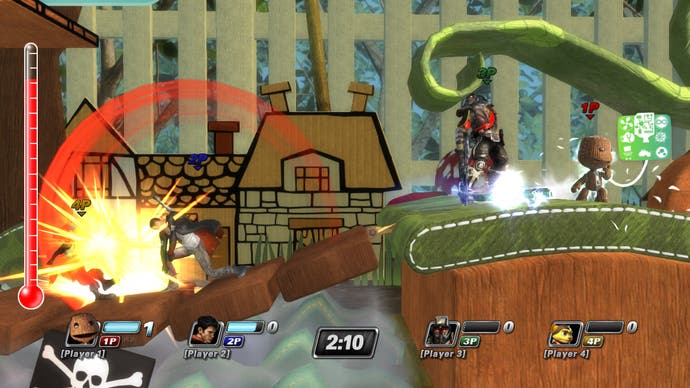
Blocking has its own button in PlayStation All-Stars Battle Royale, and you can evade-roll out of danger's way by pressing a directional input while blocking. Each character also enjoys four different throws, triggered by tilting the right stick in any of the compass-point directions while standing next to your opponent - useful for juggles. Certain matches introduce weapons, which are dropped into the scene and can be equipped by any player. These are drawn from Sony's back catalogue, such as the Hedgehog Grenade from Resistance or the Razor Claws from Ratchet & Clank, but on the whole they lack the bite to make them truly worthwhile.
Outside of matches, PlayStation All-Stars Battle Royale is a somewhat plain game. Its menus and options are functional but uninteresting and, for all the attention to detail that has been lavished on the characters and their move lists, the more general presentation lacks flair. Seth Killian's involvement (the ex-Capcom designer best known for his appearance in Street Fighter 4 as the final boss) is likely responsible for the excellent tutorials, which teach not only the basic move list for each character but also a number of combos, and there's a faint sense that the game hopes to find a place in the competitive game circuit.
But as a serious fighting game Battle Royale is, like its inspiration, too scrappy, too random and too unfocused to warrant the accolade. Meanwhile, as a celebration of lineage, the game boasts far fewer extras than 2008's comprehensive expression of the fan service fighter, Super Smash Bros. Brawl - and, perhaps, Sony lacks the lineage for a celebration on this scale. An enjoyable, workable clone then - and a surprisingly un-cynical one - but lacking the raw ingredients to truly replicate Nintendo's success in this niche.
